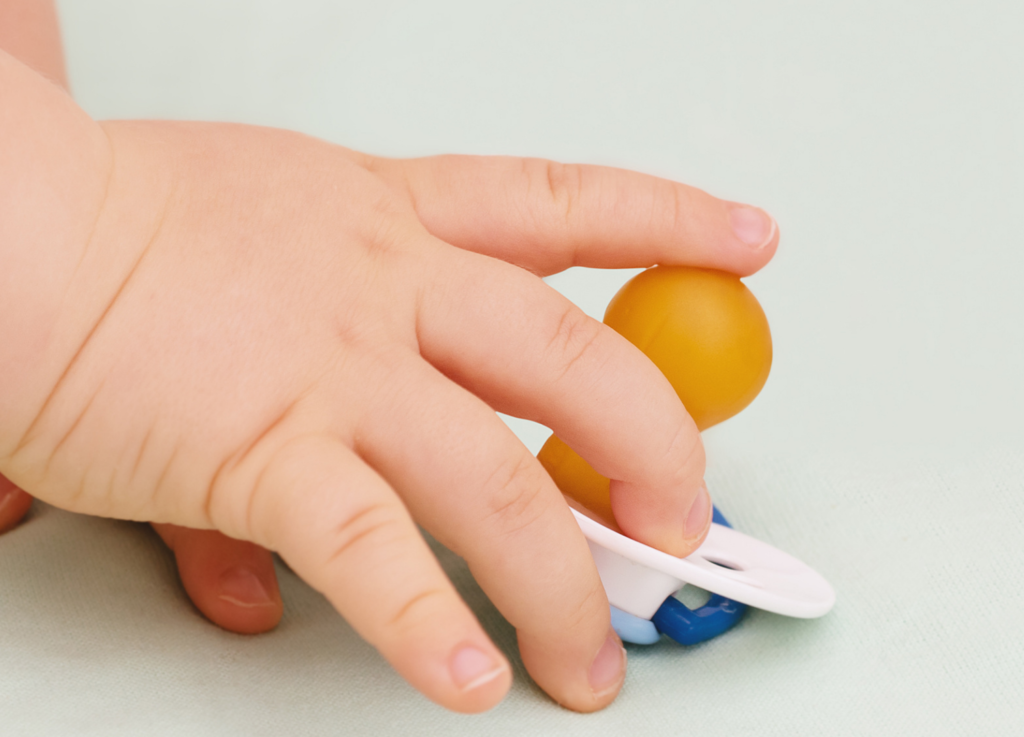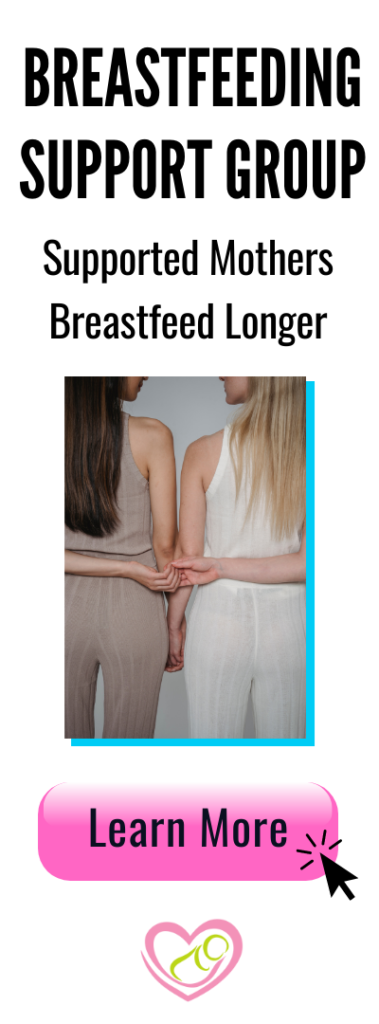What You Need To Know About Pacifiers
July 7, 2022 2024-06-20 17:39What You Need To Know About Pacifiers
What You Need To Know About Pacifiers

We know the feeling of not being able to console your crying baby. You’re stressed, sleep deprived, and maybe out of options. When all else fails, a pacifier can be a lifesaver; they can bring an inconsolable baby back to their little angelic self.
Pacifier use is a hot topic, widely debated among both healthcare providers and parents. A pacifier is a tool, and as with every tool, there are positive and negative factors to consider before using one. Your baby has an innate urge to suck even when they are not eating, a behavior that is referred to as “non-nutritive sucking”. While non-nutritive sucking is soothing to infants and beneficial for development, a pacifier is not necessarily required to meet this need. We hope this article will help guide you in making an informed decision about whether to introduce a pacifier to your baby.
The Interesting History of Pacifiers
Tools intended to calm infants have been used for thousands of years. The first soothers that we know of date back more than 3000 years ago! They were clay pigs and frogs designed with a hole in the mouth where honey could be inserted for the infant to suck on. By the 1700s, the wealthy used dummies made of silver, gold, coral, ivory, and pearl, while the commoners made them from wood and bone.

The first modern-day pacifier, called “baby comforter,” was created in 1901 by a pharmacist in New York. This device began to resemble the rubber nipple with a shield and handle we recognize today.
Benefits Of Pacifier Use
Why do we use pacifiers? Besides the obvious soothing effect they have on infants, there are actually numerous benefits.
- Reduced risk of SIDS: Studies have shown that pacifier use during bed/naptime is associated with lower rates of sudden infant death syndrome (SIDS). While we don’t know exactly why this correlation exists, the association is strong enough to recommend pacifiers as a preventative measure.
- Digestive benefits: Babies are born with immature digestive systems, and pacifiers have been shown to aid digestion after feeding.
- Preemie Feeding: Especially in premature infants, the use of pacifiers can speed up the transition to oral feeding.
- Pain reduction: Pacifiers may be particularly useful during medical procedures (like vaccines) to reduce distress.
- Equalizing Pressure: Babies are unable to “pop” their ears like we can by chewing or swallowing. The act of sucking can naturally pop their ears and ease discomfort from pressure changes on flights.
Risks Of Pacifier Use
Of course, there are also concerns that come along with pacifier use. It is important to be aware of the potential risks before using a pacifier, or any type of tool.
- Missed Hunger Cues: Babies use non-verbal cues to let their caregivers know they’re hungry. Pacifiers can mask these hunger cues, potentially resulting in an insufficient number of feedings per day, especially for breastfed infants whose mothers cannot accurately measure their intake. The last thing we want is delayed feedings due to pacifiers, which can lead to reduced milk supply and slow infant weight gain!
- Breastfeeding Issues: Pacifiers can create latching and milk transfer issues if the pacifier’s shape causes a different suck pattern than at the breast. This can lead to reduced milk supply and slow weight to gain due to inefficient milk removal at the breast, as well as nipple damage from an improper latch.
- Buildup Of Fluid: According to the American Association of Pediatrics (AAP) prolonged pacifier usage past 6-7 months has been associated with higher rates of ear infections.
- Dental Concerns: The AAP also states that prolonged pacifier usage can also lead to dental issues if continued through toddlerhood.
- Poor Hygiene: Since babies often drop pacifiers on the ground, it is relatively easy for them to develop thrush or bacterial infections if they are not regularly cleaned.
General Suggestions For Use
Keep in mind that these are general suggestions. For more specific recommendations and advice, reach out to your lactation consultant or pediatrician! We’re here for you if you would like to discuss pacifier usage.
- Wait until breastfeeding is well-established before introducing a pacifier.
- Clean all pacifiers regularly according to the directions on the package to prevent thrush or bacterial infections. Some pacifiers are dishwasher safe, but others may need to be hand-washed in hot, soapy water.
- If your infant is not interested in a pacifier, don’t force it! Not all infants tolerate them equally or at all.
- Replace any pacifier that becomes visibly worn or damaged.
- As your baby gets older, the cons of pacifier usage begin to outweigh the pros. It is generally recommended to discontinue pacifier use between the ages of 2-4. While most toddlers give up their pacifier on their own, some need to be weaned off of it. Some sources, like the AAP recommend limiting the pacifier after 6 months of age.
Safety Precautions
Of course, there are some precautions that should be taken to keep your little ones safe. Pacifiers can pose a choking hazard if they are not used properly. To ensure that your child is at the lowest risk:
- Make sure that the size of the pacifier is appropriate for your baby’s age (you can find this information on the package!)
- Do not use a loose bottle nipple as a pacifier, we know it can be tempting if you can’t find your baby’s pacifier, but it’s very dangerous!
- Never tie a pacifier around your baby’s neck, this is such an easy way for your baby to get injured.
- Do not use a long string or ribbon to attach a pacifier to a stroller, crib or car seat. You would be surprised how easy it is for an infant to become tangled in the cord, or even worse strangled.
- When choosing a pacifier, pick one that is only one continuous piece over a pacifier made of multiple parts. Two-piece pacifiers can become choking hazards once separated.
Remember, pacifiers have their pros and cons and not all babies like to use them. It is completely up to you if you decide to use one, and we are here for all of your questions and concerns! To make an appointment with one of our lactation consultants, click here.
References:
https://www.drbrownsbaby.com/the-strange-history-of-pacifiers/
https://www.medela.us/breastfeeding/articles/a-soothing-history-of-pacifiers
https://www.ncbi.nlm.nih.gov/pmc/articles/PMC3343725/
https://kellymom.com/ages/newborn/newborn-concerns/pacifier/
https://health.clevelandclinic.org/baby-pacifier-pros-and-cons/
***The information provided on our website is intended solely for general educational and informational purposes only. It is neither intended nor implied to be a substitute for professional medical advice. Always seek the advice of your physician for any questions you may have regarding your or your child’s medical condition. Never disregard professional medical advice or delay in seeking it because of something you have received in this information.***
Search
You may also like
adoption baby baby care babyproofing bottle feeding breastfeeding breastfeeding pain breast milk storage breast refusal car seat cedar park regional clogged duct clogged ducts contraceptives discharge doula engorgement exercise foremilk hindmilk hospital how to give baby a bath IBCLC labor lactation consultant low supply massage mastitis menstruation newborn care nursing strike nutrition plugged duct plugged ducts postpartum prenatal pumping relactation safety siblings sleep suck training thrush video weaning
Search



